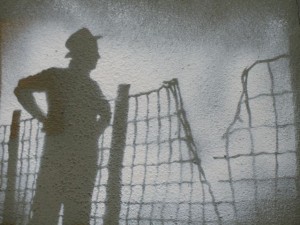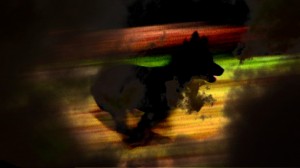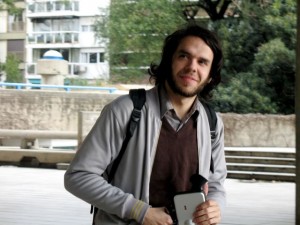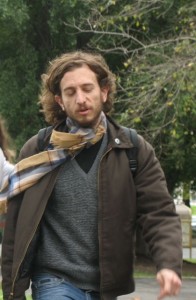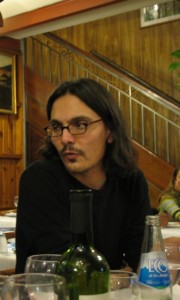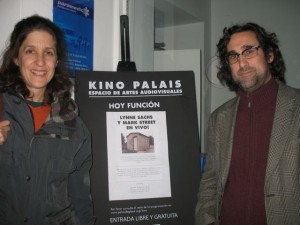An Argentine excursion: film frames, talk therapy, and ice cream
by Mark Street and Lynne Sachs (with Pablo Marin)
Published in Otherzine Feb. 2011
http://www.othercinema.com/otherzine/?issueid=25&article_id=129
In 2008, we packed our bags, got on a plane and moved to Buenos Aires for two months, studying Spanish as a family (with our two preteen daughters), shooting film and diving even deeper into the experimental film scene. We learned to speak Argentine Spanish (the “y” sound is pronounced “j”, so “Yo” becomes “Jo” and “pollo” become “pojo”), eat dinner late and spend hours sobremesa (at table) chatting and sipping wine into the night. This land can make you busy New Yorkers feel impatient and shallow, as the Argentine filmmakers we met seemed to relish spending time discussing their movies as well as the political issues of the day (multiple agricultural protests) in Europeanist distended style. Maybe it comes from the Argentine their obsession with psychoanalysis, but talk is not considered passé in Argentina.here.
Our apartment was near the Museo d’Arte Latino Buenos Aires (MALBA) where we relished the best modern art collection in town, as well as a full film schedule. We saw a Hugo Fregonese retrospective, as well as the hilarious campy ¨Esperando la Carroza¨ by Juan Carlos Lenardi which friends had recommended. What a way to learnas a way to learn Spanish, through the movies. It’s like Imagine learning English by watching “The Rocky Horror Picture Show.”
A lynchpin of the scene is the urbane and witty Ruben Guzman. A prolific filmmaker and programmer, Ruben had moved to Canada in the 80’s but recently returned to make work and program in Buenos Aires. The Kino Palais at the Palais de Glace shows 4 nights a week in a cavern-like space in the back of the museum. It’s an underground club hidden in a 19th century ice skating rink (no kidding). This is where we presented our X-Y Chromosome Project , a subjective take on global warming, to the Buenos Aires community for three nights, the same program we presented at Other Cinema, slightly adapted to a Spanish-speaking audience. Here’s what they saw:
“From archival snips of an educational film on the weather to cine poems in full blossom, New York film ‘avant-gardeners” Mark Street and Lynne Sachs present the XY CHROMOSOME PROJECT .This program of 10 short films on both single and double screen gleans audio-visual crops from the dust of the filmmakers’ fertile and fallow imaginations. In this avalanche of visual ruminations on nature’s topsy-turvy shakeup of our lives, Street and Sachs ponder a city child’s tentative excavation of the urban forest, winter wheat, and the great American deluge of the 21st Century (so far).”
Over Peruvian dinner, Ruben introduced us to Federico Windhausen, an Argentine-American media arts historian currently living in Oakland and teaching at the California College of the Arts. Windhausen is a man whose Argentine roots run deep. He is the best informal cultural guide we’ve ever encountered, anywhere, constantly suggesting film screenings, theatre and dance pieces (in the plaza of the Biblioteca Nacional, for instance) and ice cream (helado) places. The Argentine obsession with ice cream is legendary. Ice cream is a legendary obsession with Argentines. Once at an asado (barbecue) in the countrysuburbs, the conversation wound its way from politics to movies to children’s attributes with nary a raised voiceconflict. When it came time to ordering helados though however, the guests argued vehemently and passionately in defense of their favorite flavors.
Whenever we found the conversation turning to the subject of Argentine experimental film there was one name that never failed to come up: Narcisa Hirsch. Over the last forty years, this grand dame of South American cinema has earned a well deserved reputation for making extraordinary films that are both formally rigorous and deeply personal. Inspired by the feminists and the Fluxus artists she met and worked with in Europe in the 1960s and ‘70’s (including renowned artist Carolee Schneemann), Narcisa brought back her profound appreciation for North American avant-garde film to the artists’ community she knew and loved in Buenos Aires. In the company of her good friend Ruben and Paula Felix-Didier, the director of the Museo de Cine, Lynne spent was fortunate to spend a fascinating afternoon with Narcisa in her home-studio discussing her forty year filmmaking career, her children and grandchildren and her farm in Bariloche, in the south of Argentina.
Pablo Marin is one of the guiding forces of experimental cinema in Buenos Aires, and his blog La Region Central (title taken from the Michael Snow film) is an amazing living document. (http://laregioncentral.blogspot.com/)
Once Pablo and we (sans Lynne) spent the hour just before dusk shooting 16mm film around some stands that sell meat and sausages right next to the Reserva Ecologica. Later Mark and hewe drank beers in a café on the Avenida Corrientes (sort of the psychic artery of the city). Mark asked him to give a quick historical overview of the past.
“The early Argentine experimental period is represented by just a bunch of separate films, made by filmmakers that didn’t pursue a total exploration of the medium and, most importantly, didn’t think in terms of a community or movement. Horacio Coppola, a leading name in Argentinian still photography, made a few films during the 1920s and ‘30s. His most important is “Traum”, a 16mm film that reminds me of the French-German Surrealists.
“Víctor Iturralde and Luis Bras were a couple of pioneers of experimental animation in the ‘50s and ‘60s. They mostly painted and scratched on celluloid films in 35mm, 16mm and Super 8mm.
“The 1970s and 80s were a strong and vital period for experimental film in Argentina. An actual alternative film community was born. During the 70s, we experienced a military coup d’etat which resulted in little contact with the experimental film world abroad. Our productions were more scarce and individualized. Many films were made (mostly all in 8mm and Super 8) but the conditions of exhibition were totally underground and unconnected (garages, houses, etc). All this began to change in the early 80s when Buenos Aires’ Goethe Institute began showcasing as well as protecting these films and filmmakers. Under the Goethe’s umbrella (to put it visually), this kind of film practice could grow without fear of persecution (that’s why the government reaction was never that intense) and with more support for the movement collectively. The highest point of this Goethe period (if one could call it that) was in 1980, when the Institute held a workshop of experimental film with German filmmaker Werner Nekes. In this period many artists were working, such as Claudio Caldini (Super 8, Single 8), Narcisa Hirsch (16mm, Super 8) and Jorge Honik (Super 8). Other names include Juan Villola, Horacio Vallereggio, Marie Louise Alemann, Juan José Mugni and Silvestre Byrón. The films where shown in bigger, more social, environments but the reaction of the audience was mostly hostile. Once at a screening of Caldini’s “Gamelan” the audience started booing and shouting and turning off and on the lights ! It is also important to note that in this period these filmmakers were more in touch with international, experimental film production. To name a few screenings, there’ was Jonas Mekas’ 1962 screening of “Guns of the Trees” at Mar del Plata Film Fest and in 1965 the Di Tella Art Institut screened a bunch of New American films (Mekas, Brakhage, Warhol, etc.). Besides that, Narcisa Hirsch traveled a lot to buy film prints that even today represent the most important private, experimental film archive in Buenos Aires.
“Since 1990, experimental media has for the most part switched drastically towards video even though makers such as Caldini and Hirsch continue to produce films. The opening of several film schools makes experimental film more accessible and more studied. The public screenings of international works have gained a solid following mainly through Buenos Aires Independent Film Festival and Mar del Plata, and it is also more common to see screenings of local experimental works at these venues. Some of the important names are: Andres Denegri, Gustavo Galuppo, Gabriela Golder, Ruben Guzman (all in video), Daniela Cugliandolo (Super 8, video) and Sergio Subero (Super 8, video).”
With this backdrop for experimental film all around us, we tried to let ourselves become charged as artists inwith the poetry Buenos Aires, too, and move ahead with our own work. Mark shot 16mm film and videotape attempting to capture the idiosyncrasy of the city, following up on his film “Hidden in Plain Sight” (a city symphony film shot in Dakar, Hanoi, Marseille and Santiago de Chile). He became obsessed with the cartonieres, the gleaners who sift through trash to sell cardboard on the outskirts of town, and the portreros, the men who sit behind glass windows at middle class apartment buildings watching and waiting. He is currently editing the project, tentatively titled “Fans of Argentina”(based on the store displays that feature industrial fans running at different speeds, like enormous film shutters).
While making her most recent film, “Wind in Our Hair” (Con Viento en el Pelo), Lynne worked with With Argentine super 8 filmmakers Leandro Listorti, Pablo Marin and Tomas Dota., Lynne shot “Wind in Our Hair” is , an experimental narrative inspired by Julio Cortazar’s short story “Final del Juego” about four girls (our daughters Maya and Noa and their two Argentine friends Lena and Chiara Peroni) who stand by a passing train everyday posing like “sculptures and attitudes.” The film is very much about longing, the rite of passage between childhood and adulthood, and performance of an inner self. The crew of cinema friends shot with a real potpourri of formats – from obsolete Kodak Regular 8 to Super 8mm, 16mm and video. Our daughters Maya and Noa and their two Argentine friends Lena and Chiara Peroni were hopping on and off trains throughout the summer as part of the production. The film used the entire city as a set – including the Tigre Train line that sweeps through the Parque Palermo, the majestic Retiro train station, the flea market in San Telmo’s Plaza Dorrego, and a quiet backyard on the outskirts of the city. “Wind in Our Hair” film had its Bay Area premiere at Other Cinema in April of 2010.
Our last day in Buenos Aires we walked a few blocks to a huge multiplex and caught Lucretia Martel’s brandnew “La Mujer Sin Cabeza” while our kids took in a dubbed version of “Mamma Mia” at the screen next door. As we munched a last alfajore walking back to the apartment to collect our security deposit we came up with the idea of curating a film screening in NYC upon our return.
Six months later, on February 21, 2009, we showed thirteen Super 8, video and 35mm films from Argentina at Anthology Film Archives in New York City. In curating “Ventana al Sur: An Evening of Argentine Experimental Film” we culled films from a whole array of non-traditional works made over the last 3 decades, some by veteran masters and mistresses (Leandro Katz, Liliana Porter and Narcisa Hirsch) and some by young upstarts and renegades (Pablo Marin, Ruben Guzman, Macarena Gagliardi, Sergio Subero, Leandro Listordi, Ernesto Baca) with newfound passions for the moving image. Here are descriptions of just a few of the works we showed:
Leandro Katz’s “Los Angeles” (5 min., 16mm, 1976) is a portrait of a small community living by the railroad tracks in the banana plantation region of Quiriguá, Guatemala. Originally a single take, this film alternates equal number of moving frames and frozen frames as the camera tracks alongside the train station.
Narcisa Hirsch’s “Workshop” (10 min.,16mm 1977) is a structuralist vision. One wall of the filmmaker’s studio as seen through a fixed camera. We see photos she’s stuck on the wall, then there is a dialogue with a male friend to whom she is describing the rest of the walls that you don’t see. A “one upmanship” of a similar film by Michael Snow where he describes a wall of his studio- workshop, by describing what one CAN see.
“Bajo Tierra” (4 1/2 min., Super 8, sound on CD, 2007) is Pablo Marin’s portrait of filmmaker Claudio Caldini who makes a new cinematic offering in front of the no-longer-industrialized Kodachrome.
In “Montevideo” (4 minutes, DVD, 2008) Leandro Listorti looks at the capital of Uruguay reveals, briefly, its characteristic of a Doppelgänger City: a single place cut in two spaces where two pairs of creatures explore the limits of the travelogue.
In “Stock” (5 minutes, 2007, mini DV ) Ruben Guzman follows a boy from La Cruz who walks to school to read aloud the stock market report from the newspaper. We are witness to the last day of capitalism.
Ernesto Baca’s “Nunca Fuimos Allah Luna” (7 min., 35mm, 2008) presents two characters on split screens, conversing and arguing as the city unspools kinetically behind them.
The show was packed with Argentine expats, curiosity seekers, and hard core experimentalists who wanted to see how subversive cinematic effusions looked from the land where summer is winter and winter is summer. Since we had some of our first and best film dates at Other Cinema in the early 1990s when we were denizens of the Mission District, we tried to recreate that kind of informal, bon vivant celebration of the senses and the screen here in downtown Manhattan. We served yerba mate from communal gourds at the show—there’s no caffeine in mate, but there is something in there, and the room seemed to float on the wings of a filmic reverie. We also served sweet dessert churros (filled with dulce de leche of course) purchased at the famous Buenos Aires Bakery in Queens. In 2009, we presente this program at the Pacific Film Archive along with an excerpt Federico Windhausen’s “When the Pueblo Was Hollywood”.
On our way home to Brooklyn, we played back images from the screen in our heads—the frantic single frame pace of Narcisa Hirsch’s “Aleph”, the wry and witty animated vignettes of Liliana Porter’s “Para Usted/For You” and the truncated urban space of Pablo Marin’s “Sin Titulo”, shot on an apartment building roof in Buenos Aires. As distinctive as New York is, it also recalls other cities, in a similar way that Buenos Aires can seem like Paris or Madrid, refracted, if you squint your eyes just right. As revelers ducked in and out of bars at 11 pm, it felt as if an Argentine night was just beginning.
In 2009, the Pacific Film Archive presented out “Ventana al Sur” program in Berkeley along with an excerpt from Federico Windhausen’s “When the Pueblo Was Hollywood”, a film he shot in the north of Argentina. Lucky for us and the Bay Area audience, Windhausen was able to be there for the show to field questions on Argentina Cinema, a topic on which he, like us, is passionate.

